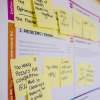Prototyping is done on Day 4 of a design sprint, or the day before usability testing if you’re running shorter design sprints. By this stage, you would have worked out the challenge, goals, and the solution you’re building for testing.
It will be a busy day, especially for the design team. You want to make sure that you have all your ducks aligned before you begin the day. After spending at least 3 days on designing a solution, you want to be building something decent for the users. These are my tips on what to do to get the most out of your prototyping day.
Tip #1: Sort out everyone’s roles
Meet up earlier to sort out everyone’s roles, tasks, and agenda, especially the core team. The core team is made up of people who will develop the prototype, while the experts will only come in to check the progress and give feedback.
A core team consists of:
- The Maker: someone who designs and develops the prototype, usually designers, developers, or engineers.
- The Stitcher: someone who stitches everything together, so the prototype is smooth and workable.
- The Writer: someone who writes the copy and handles the overall messaging.
- The Asset Collector: someone who collects data and other assets for the team.
- The Facilitator or the Interviewer: someone who is a project manager throughout the day, checking on tasks, getting feedback, preparing the usability testing and trial runs.
Tip #2: Use the right tools
We use Figma for design and Invision for prototyping in our sprints. They’re easy to use, and have all the features we need to prototype, review and test. And our user testers have no problem using them in usability testing. Other popular ones are Adobe XD suite, Sketch, Origami and Azure.
Ultimately, use what you’re comfortable with and what is easy for users to get comfortable with.
Tip #3: Divide and conquer
When the intended prototype is big, do a divide and conquer. The Maker will be the busiest in the core team, designing and refining according to spec. Either you add in another maker, or you can utilise other people in the core team or stakeholders.
The rest of the core team will finish their tasks earlier. They can offer support for other things such as testing the build, preparing the usability trial runs, and gathering feedback. The key thing is proper planning.
Tip #4: Remember the sprint goal
When you’re building something for testing, it’s easy to get carried away in the nitty gritty details. After all, you feel like you need to present something good for the users. But remember that the final product may look different than the prototype. They just serve the same goal. Design sprints are to test your ideas and hypothesis. Don’t lose sight of that.
If a user can understand and use your prototype, it is good enough. If at any time, you’re spending too long on just one element, it’s time to move on. Don’t waste time designing stuff that doesn’t add value to the usability test. You want valuable and insightful feedback, not a fancy tool that’s not developed enough for actual usage.
Tip #5: Use your asset libraries
Building the prototype usually takes up the whole day. But it can be shorter if you’ve got a lot of assets in your digital library. Reuse and adapt them in a prototype. Or build from a previous prototype.
There’s also a reason there is a Stitcher in the core team. Often, you’re not building something from scratch but reusing components and redesigning existing elements – stitching them together.
Tip #6: Always do a quick review
Don’t skip a prototype review. You can either do it twice or once during the day. It doesn’t have to be extensive – just a quick one will do.
I usually do it towards the end of the day around 3pm because most tools will let people preview the work in progress. Get the stakeholders and experts to check in throughout the day, so they know what’s going on before coming in for a review. It also keeps the review session short and sweet too.
And leave enough time for the core team to tweak the prototype for next day testing. You can easily do the realistic and simpler changes. For the rest, keep it for future notes.
Tip #7: Conduct a test run
The next day of usability testing will be busy too. And with users coming in or dialling in, you never know what curveballs you’re going to get. Late showups, technical problems, extra user training, longer testing time, you name it.
Best to do a trial run of the prototype the day before. You can do parallel testing and building to avoid nasty surprises at the end of the day. And don’t forget to prepare your test scripts, schedule, tools, and setup too. You’ll come in the next day fresh and ready to handle your user testers.







